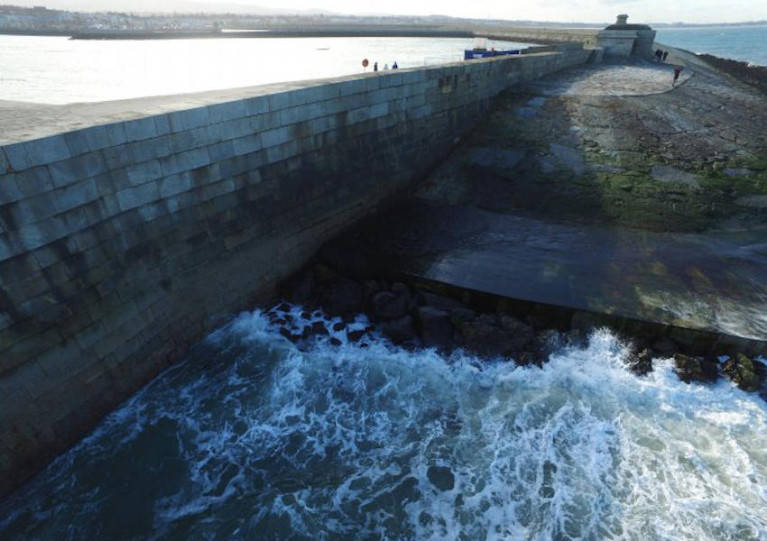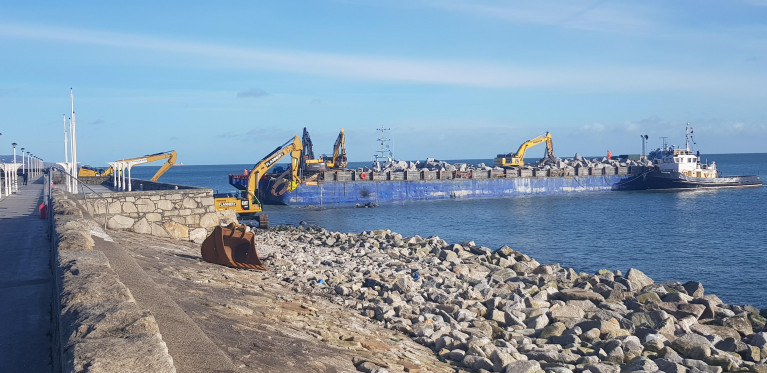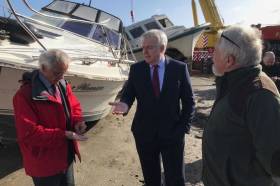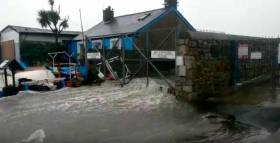Displaying items by tag: Storm Emma
Concerns Over Return of ‘Beast From the East’ and Stormy Conditions That Damaged Irish Harbours
Ireland could be set for the return of the ‘Beast from the East’ with meteorologists eyeing an upcoming weather phenomenon with concern, as Independent.ie reports.
Experts say that a so-called sudden stratospheric warming forecast for the coming days could cause the jet stream, which helps moderate Ireland’s climate, to meander more — bringing an outbreak of cold and dry weather later this month.
Similar conditions brought about the ‘Beast from the East’ blizzard in late February 2018 that blanketed much of the country with snow ahead of Storm Emma, which caused significant damage to harbours around Ireland and the UK.
Dun Laoghaire Harbour was among the worst affected, with the storm eroding coastal defences from both the West and East Piers that took more than two years to be remediated.
Howth’s historic Howth 17s also bore the brunt of the storm, as Force 12 gales blew the roof off a storage shed housing seven of the boats – though only two of them suffered serious damage.
Independent.ie has more on the story HERE.
Works to repair storm damage to the East and West Piers in Dun Laoghaire Harbour during Storm Emma two years ago have now been completed, bar restoration of the sun shelter on the East Pier.
Movement restrictions to control the spread of coronavirus slowed the final weeks of works, which involved repairs to coastal defences on the East Pier as reported on Afloat.ie in early March.
Now Dun Laoghaire-Rathdown County Council has provided an update of the repairs progress over a number of phases, from emergency works to reconstruction of the East Pier’s upper level wall, replacing 400 tonnes of rock armour washed away in the storm, and shoring up the West Pier’s roundhead resentment.
Restoration of the East Pier’s sun shelter remains outstanding and the council says it is features in its Capital Projects plan awaiting funding to proceed.
Barge Departs But Works to Shore-Up Storm Damage Continue at E. Pier, Dun Laoghaire Harbour
Works to repair damage at the East Pier, Dun Laoghaire Harbour in Dublin Bay, that began last year on coastal defences should be completed in the coming weeks, writes Jehan Ashmore.
According to Dun Laoghaire-Rathdown County Council the works to replenish rock-armour from the damage caused by Storm Emma in 2018 should be completed by the end of March.
As Afloat previously reported a barge laden with 1,700 tonnes of Cornish granite boulders are being used to repair the outside of the East Pier.
Such work to position the rocks where required to shore-up coastal defences, is clearly evident when seen from the shores of Scotsman Bay as the new rocks are grey in colour compared to the surrounding slopes along the East Pier.
It is almost a fortnight since the barge towed by tug, Vanguard, departed Dun Laoghaire Harbour and back to the UK. DLRCoCo also confirmed to Afloat that this was the only shipment used in the project where contractors hired by the council are using heavy machinery.
The machinery involving digger/grabbers had to be tranported by sea (landing craft, James) from within the harbour to the outside of the East Pier due to accessiblility reasons.
Dun Laoghaire-Rathdown County Council have engaged L&M Keating Ltd to carry out further repairs to the end of the West Pier and behind the sun shelter on the East Pier of Dun Laoghaire Harbour.
The works include repairing damage to the revetments, and replacing rock armour removed by Storm Emma in March 2018. The council expects these works to be completed by Christmas.
Members of the public are requested to obey safety signage and stay clear of the works areas on both piers.
Afloat.ie understand that a budget shortfall resulting from a lower than expected insurance payout over damage sustained during Storm Emma means that some works, unclosing the rebuilding of the East Pier’s sun shelter, cannot be completed at this time.
#Holyhead - The north Wales marina in Holyhead wrecked in a storm which saw dozens of vessels sunk or damaged is to receive a £100,000 Government cash injection to help with the ongoing clean-up.
Storm Emma reports Daily News, battered the coast in March of this year, wreaking severe damage on Holyhead Marina as well as around 75 vessels.
Since then, significant progress has been made to clean up the area, with an estimated 40 tonnes of polystyrene and 3,000 litres of oil recovered from the marina and neighbouring beaches.
This has been made possible thanks to the efforts of a multi-agency team involving Anglesey Council, NRW, and the Coastguard among others, and the time and dedication shown by local volunteers.
During a visit to the marina this morning (MAY 10) First Minister Carwyn Jones said: “From day one agencies and volunteers have worked tirelessly on the clean-up and I saw for myself the dedication and professionalism of those involved. I thank them for all they have done and continue to do.
To read further comments by the Welsh First Minister, click here.
Last month on the other side of the Irish Sea a group of cadets visiting Greystones as previousy reported ironically found debris from the damaged marina washed ashore
Dublin Harbours Feel the Brunt of Storm Emma
Flooding in South Dublin coastal towns and villages came when high tides arrived at lunch time today.
In Bulloch Harbour in Dalkey, on the southern tip of Dublin Bay, storm waves swept through the harbour as Bay waters threatened the top of the quay.
At nearby Coliemore Harbour a boat was capsized in the small harbour in Dalkey Sound
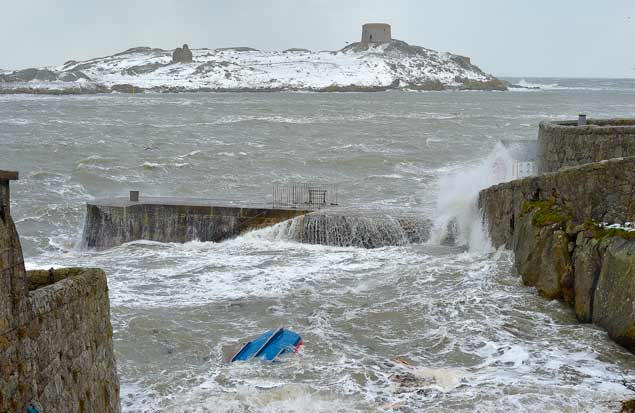 Coliemore harbour Photo: Michael Chester
Coliemore harbour Photo: Michael Chester
At Dun Laoghaire Harbour, boats are snug in the country's biggest marina but there is reported damage to pontoons and boats moored elsewhere.
At Seapoint, in Monkstown, County Dublin the shoreline railway there resembles a canal as Storm Emma continues to rage this afternoon.
The scene in Sandycove, County Dublin where mountainous seas caused local flooding.
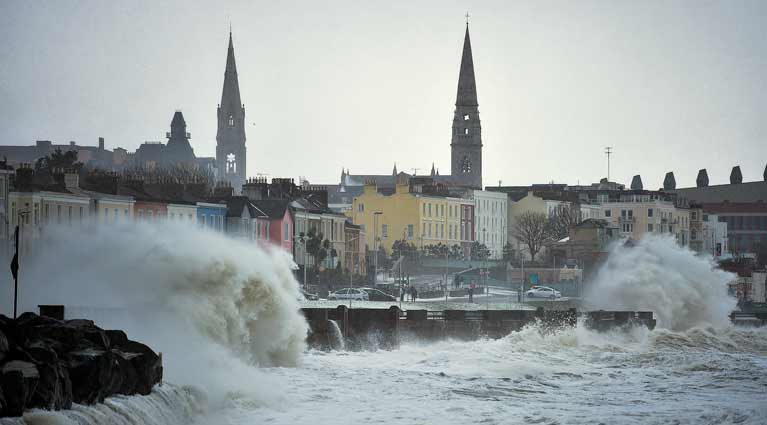 Waves pound Newtownsmith at Sandycove. Photo: Michael Chester
Waves pound Newtownsmith at Sandycove. Photo: Michael Chester
Despite warnings to the public to stay out of the water, a woman swimmer had to be rescued from the harbour in Sandycove.
A swimmer had to be rescued from the sea at the Forty Foot in Sandycove today. Very high tides and rough conditions in the area. #StormEmma Video credit: Simon Johnston pic.twitter.com/030kKQ94LU
— Aengus Cox (@AengusCox) March 2, 2018
Earlier today, as Afloat.ie reported here, breaking waves in north Dublin at Howth have caused damaged to a pierside shed where some historic yachts are stored.
Today's high tide at noon added to Howth's storm problems with the northeast gale little eased, and the waves continuously sweeping over the East Pier. While the actual damage timeline is still confused, it may well be that the worst of the destruction to the sheds at the end of the pier housing seven of the Howth 17s did not occur until around 1.30pm today, with reports of at least two boats seriously damaged



























